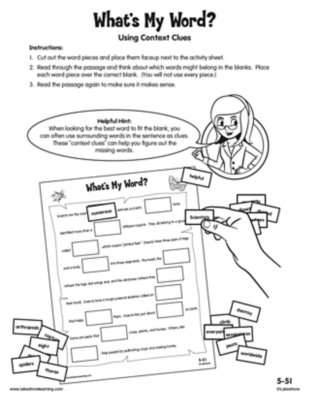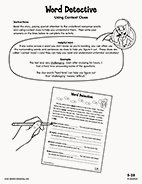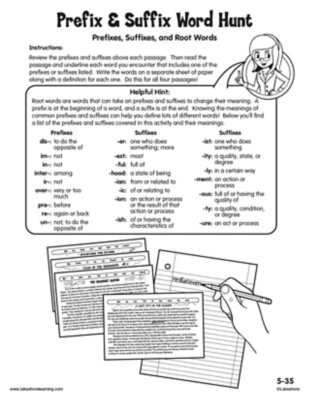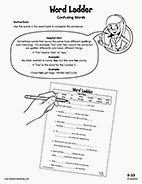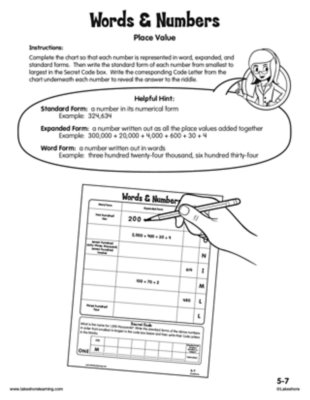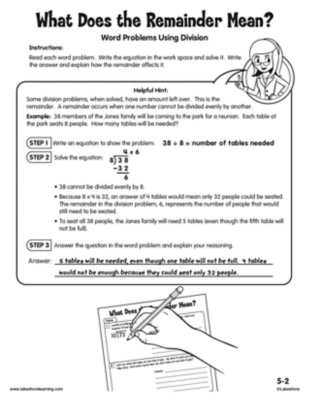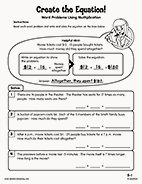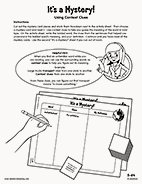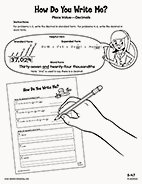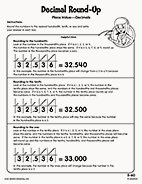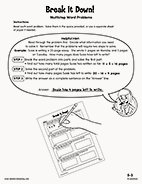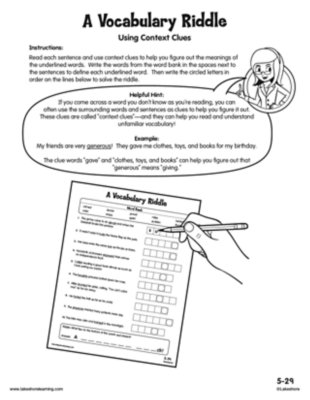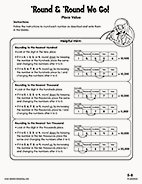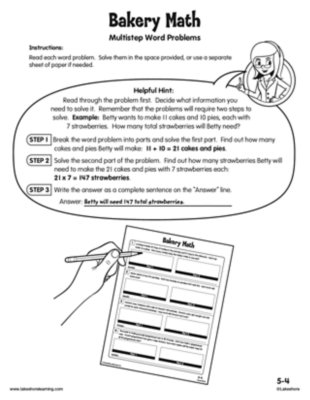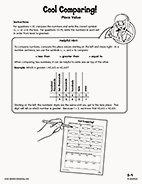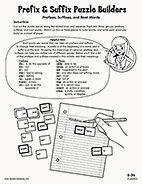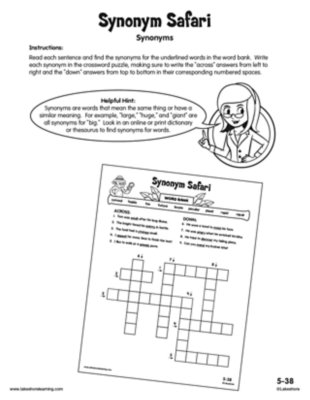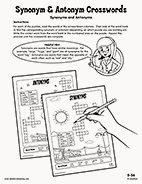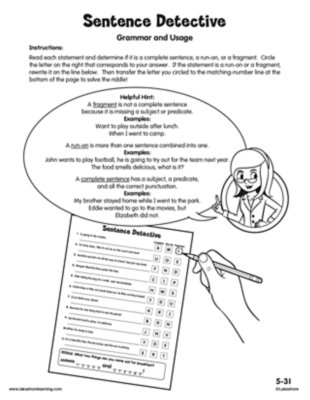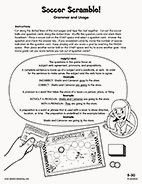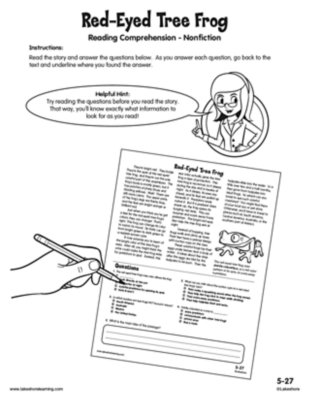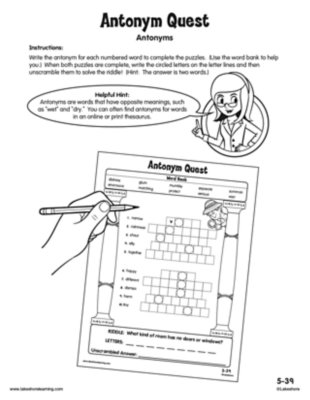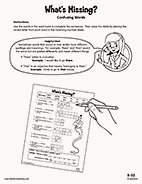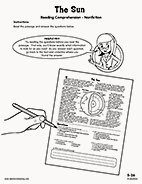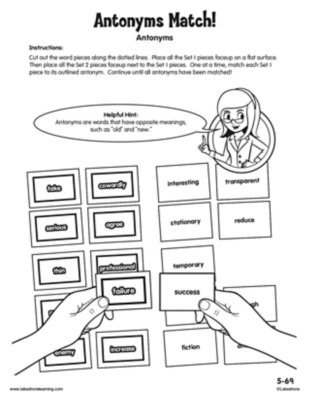Narrow by Grade
- Infant (0)
- Toddler (0)
- Preschool (0)
- Pre-K (0)
- Kindergarten (0)
- 1st (0)
- 2nd (0)
- 3rd (0)
- 4th (0)
- 5th (25)
- 6th & Up (0)
Grade
Narrow by Age
- 0-18m (0)
- 18-36m (0)
- 3 yrs. (0)
- 4 yrs. (6)
- 5 yrs. (33)
- 6 yrs. (51)
- 7 yrs. (55)
- 8 yrs. (39)
- 9 yrs. (31)
- 10 yrs. (25)
- 11 yrs. & Up (0)
Age 10 yrs.
25 results for "word"
During fifth grade, your child will learn to figure out the meaning of an unfamiliar word or phrase by using clues in the text, such as cause/effect relationships and comparisons. For example, in the following sentence, you can determine that the word “chastened” means “punished” by looking at the cause and effect: “When Judy found out that her son had cheated, she chastened him by taking away his video games.”
View worksheetWhen entering fifth grade, your child should be able to figure out the meaning of an unfamiliar word or phrase by using clues in the text, such as definitions or examples.
View worksheetWhen entering fifth grade, your child should be able to use common, grade-appropriate Greek and Latin prefixes, suffixes and roots to figure out the meaning of a word. For example, “telegraph,” “photograph” and “autograph” all contain the Greek root “graph,” which refers to something that is written or drawn.
View worksheetWhen entering fifth grade, your child should be able to correctly use frequently confused words, such as “to” and “two” or “there” and “their.”
View worksheetWhen entering fifth grade, your child should be able to compare and round multidigit numbers. Your child should also be able to read and write multidigit numbers in number, word and expanded form. For example, 765; seven hundred sixty-five; 700 + 60 + 5.
View worksheetWhen entering fifth grade, your child should be able to multiply and divide to solve word problems and be able to solve multistep word problems that involve multiplication and division.
View worksheetWhen entering fifth grade, your child should be able to multiply and divide to solve word problems and be able to solve multistep word problems that involve multiplication and division.
View worksheetDuring fifth grade, your child will learn to figure out the meaning of an unfamiliar word or phrase by using clues in the text, such as cause/effect relationships and comparisons. For example, in the following sentence, you can determine that the word “chastened” means “punished” by looking at the cause and effect: “When Judy found out that her son had cheated, she chastened him by taking away his video games.”
View worksheetDuring fifth grade, your child will learn to read and write decimals in standard form, word form and expanded form to the thousandths place and round decimals to any place.
View worksheetDuring fifth grade, your child will learn to read and write decimals in standard form, word form and expanded form to the thousandths place and round decimals to any place.
View worksheetWhen entering fifth grade, your child should be able to solve multistep word problems using addition, subtraction, multiplication and division, including problems with remainders.
View worksheetWhen entering fifth grade, your child should be able to figure out the meaning of an unfamiliar word or phrase by using clues in the text, such as definitions or examples.
View worksheetWhen entering fifth grade, your child should be able to compare and round multidigit numbers. Your child should also be able to read and write multidigit numbers in number, word and expanded form. For example, 765; seven hundred sixty-five; 700 + 60 + 5.
View worksheetWhen entering fifth grade, your child should be able to solve multistep word problems using addition, subtraction, multiplication and division, including problems with remainders.
View worksheetWhen entering fifth grade, your child should be able to compare and round multidigit numbers. Your child should also be able to read and write multidigit numbers in number, word and expanded form. For example, 765; seven hundred sixty-five; 700 + 60 + 5.
View worksheetWhen entering fifth grade, your child should be able to use common, grade-appropriate Greek and Latin prefixes, suffixes and roots to figure out the meaning of a word. For example, “telegraph,” “photograph” and “autograph” all contain the Greek root “graph,” which refers to something that is written or drawn.
View worksheetWhen entering fifth grade, your child should be able to understand words by relating them to their opposites (antonyms) and to words with similar but not identical meanings (synonyms).
View worksheetDuring fifth grade, your child will learn to use the relationship between synonyms (words with similar meanings) and antonyms (opposites) to better understand each of the words.
View worksheetWhen entering fifth grade, your child should know how to correctly use words in sentences and should know many rules of English grammar and usage, including rules about relative pronouns (which, that), relative adverbs (where, when, why), the correct order of adjectives and more. Your child should also know how to use correct punctuation and capitalization when forming sentences and paragraphs.
View worksheetWhen entering fifth grade, your child should know how to correctly use words in sentences and should know many rules of English grammar and usage, including rules about relative pronouns (which, that), relative adverbs (where, when, why), the correct order of adjectives and more. Your child should also know how to use correct punctuation and capitalization when forming sentences and paragraphs.
View worksheetWhen entering fifth grade, your child should be able to read, analyze and understand level-appropriate nonfiction reading passages, finding the main idea and important details, comprehending key words and phrases, comparing different accounts of the same event or topic and making inferences.
View worksheetWhen entering fifth grade, your child should be able to understand words by relating them to their opposites (antonyms) and to words with similar but not identical meanings (synonyms).
View worksheetWhen entering fifth grade, your child should be able to correctly use frequently confused words, such as “to” and “two” or “there” and “their.”
View worksheetWhen entering fifth grade, your child should be able to read, analyze and understand level-appropriate nonfiction reading passages, finding the main idea and important details, comprehending key words and phrases, comparing different accounts of the same event or topic and making inferences.
View worksheetDuring fifth grade, your child will learn to use the relationship between synonyms (words with similar meanings) and antonyms (opposites) to better understand each of the words.
View worksheet